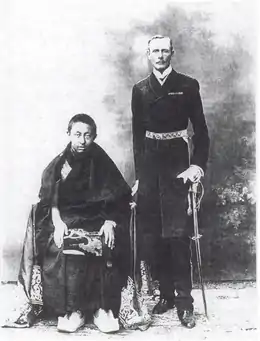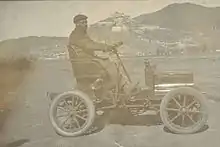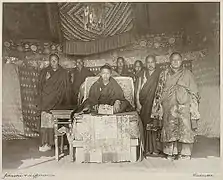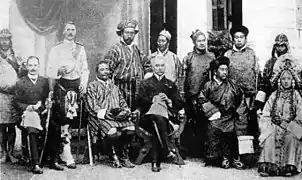William Frederick Travers O'Connor
William Frederick Travers O'Connor ([1], Irlande[2] - [3]) est un militaire (Capitaine, Lieutenant-Colonel), interprète, attaché commercial et écrivain britannique qui séjourna au Tibet au début du XXe siècle.

| Naissance | |
|---|---|
| Décès |
(à 73 ans) Chelsea |
| Nationalité | |
| Formation | |
| Activités |

Biographie


Frederick O'Connor est né en 1870, de Matthew Weld O'Connor et Harriette Georgina O'Reilly. Il a été formé à la Charterhouse School et l'Académie royale militaire de Woolwich.
William Frederick Travers O'Connor servit dans la vallée de Swat et la campagne de Tirah (en) entre 1897 et 1898, à Gilgit entre 1899-1903, avant d'être nommé interprète en langue tibétaine et secrétaire de la mission Younghusband à Lhassa entre 1903-1904[4].
William Frederick Travers O'Connor fut détaché du Département Politique du Gouvernement indien et nommé secrétaire et interprète de Francis Edward Younghusband durant l'invasion britannique au Tibet (1903-1904). Il resta à Gyantsé au Tibet quand les Britanniques se retirèrent de Lhassa, avec le titre d'agent commercial entre 1904 et 1908[5]. Il fut le premier agent commercial britannique à Gyantsé[6].
Au cours de sa mandature au Tibet, O'Connor se lia d'amitié avec le 9e panchen-lama et l’amena à Calcutta en 1905 où ce dernier rencontra, début 1906, le vice-roi des Indes Gilbert Elliot-Murray-Kynynmound, le Chogyal du Sikkim Thutob Namgyal, et le futur roi du Bhoutan Ugyen Wangchuk[7]. Le panchen-lama y rencontra également le prince de Galles et futur roi George et la reine Mary. Le capitaine O'Connor possédait une Peugeot Bébé, une des deux premières automobiles à avoir été acheminées à travers l'Himalaya au Tibet en 1907, l'autre étant une Laurin & Klement offerte par le gouvernement indien au panchen-lama[8]. En raison de nombreux problèmes avec les agents chinois, O'Connor fut contraint à partir en 1908[9].
Il fut ensuite Consul britannique à Shiraz en Perse entre 1912 et 1915. Il est devenu par la suite le résident britannique au Népal entre 1918 et 1920[5].
Il est l'auteur de plusieurs ouvrages sur le Tibet, dont l'un, Report on Tibet, décrit avec une grande précision l'état des connaissances sur le Tibet en 1903[10].
Distinctions
- Ordre de l'Étoile d'Inde, CSI
- Ordre de l'Empire des Indes, CIE
- Ordre royal de Victoria, 1922
- Knight Bachelor, 1925
Publications
- Things mortal, 1940
- On the frontier and beyond: a record of thirty years' service, 1931
- Lhasa: an account of the country and people of Central Tibet (1905), avec Perceval Landon et Herbert James Walton,
- Folk Tales from Tibet with Illustrations by a Tibetan Artist and Some Verses from Tibetan Love Songs, 1906
- Report on Tibet, 1903
Références
- (en) John F. Riddick, Who was who in British India, 1998, p. 275 : « O'CONNOR, Sir (William) Frederick (Travers) Indian Political Service; b 30 July 1870 in Ireland; s of Matthew Weld O'Connor and Harriette Georgina O'Reilly; m unmarried. Educ; Charterhouse; RMA, Woolwich. 1890 commissioned as Lieut, and posted to RA; 1897-98 participated in Swat Valley and Tirah Campaigns; 1899- 1903 »
- (en) Alex McKay, Tibet and the British Raj: The Frontier Cadre, 1904-1947, 1997 p. 226 : « History Lieutenant-Colonel Sir William Frederick Travis O'CONNOR CSI CIE CVO. (1870-1943) Born: Ireland, son of landowner. Educated: Charterhouse, RMA Woolwich. . Indian Army, Indian Political Department. »
- (en) The Geographical Journal, Volumes 103 à 104, 1944, p. 304 : « Colonel Sir Frederick O'Connor was at his death, on 14 December 1943, a member of our Council, greatly valued for his immense knowledge of Himalayan countries and the Tibetan language. »
- (en) Images of First Cars to Cross the Himalayas into Tibet 102 Years Ago and Secret Photos of Japan from 1898 for Sale, Artdaily.org, 6 octobre 2009.
- (en) Hui-Min Lo, The Correspondence of G. E. Morrison 1912-1920, Éditeur CUP Archive, 1978, (ISBN 0521215617 et 9780521215619)
- (en) Jennifer Siegel, Endgame: Britain, Russia and the Final Struggle for Central Asia.
- Fabienne Jagou, Le 9e Panchen Lama (1883-1937) : enjeu des relations sino-tibétaines, Publications de l'École Française d'Extrême-Orient : Monographies, no. 191, 2004, (ISBN 2855396328), p. 92.
- (en) Frederick O'Connor, On the frontier and beyond: a record of thirty years' service, 1931, p. 109 : « I had brought out with me a small 8 h.p. motor-car as a present to the Tashi Lama from the Government of India, and also my own little 61/2 h.p. Baby Peugeot »
- (en) Tibetan Bulletin, Numéro 2, 1988, p. 11 : « After 1904 the British kept Trade Agents in Tibet, usually with their families, they were stationed in Gyantse and Yatung and along with the Political Officer in Sikkim visited Lhasa from time to time. The first BTA Gyantse was O'Connor(1904- 1908) who had many problems with the Chinese Agents which forced him to leave in 1908. »
- Philippe Forêt, La véritable histoire d'une montagne plus grande que l'Himalaya: les résultats scientifiques inattendus d'un voyage au Tibet, 1906-1908, et de la querelle du Transhimalaya, 2004 (ISBN 2749503469 et 9782749503462), p. 164.